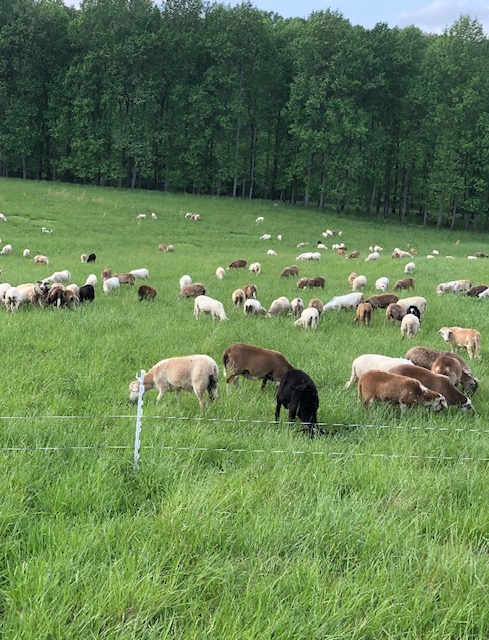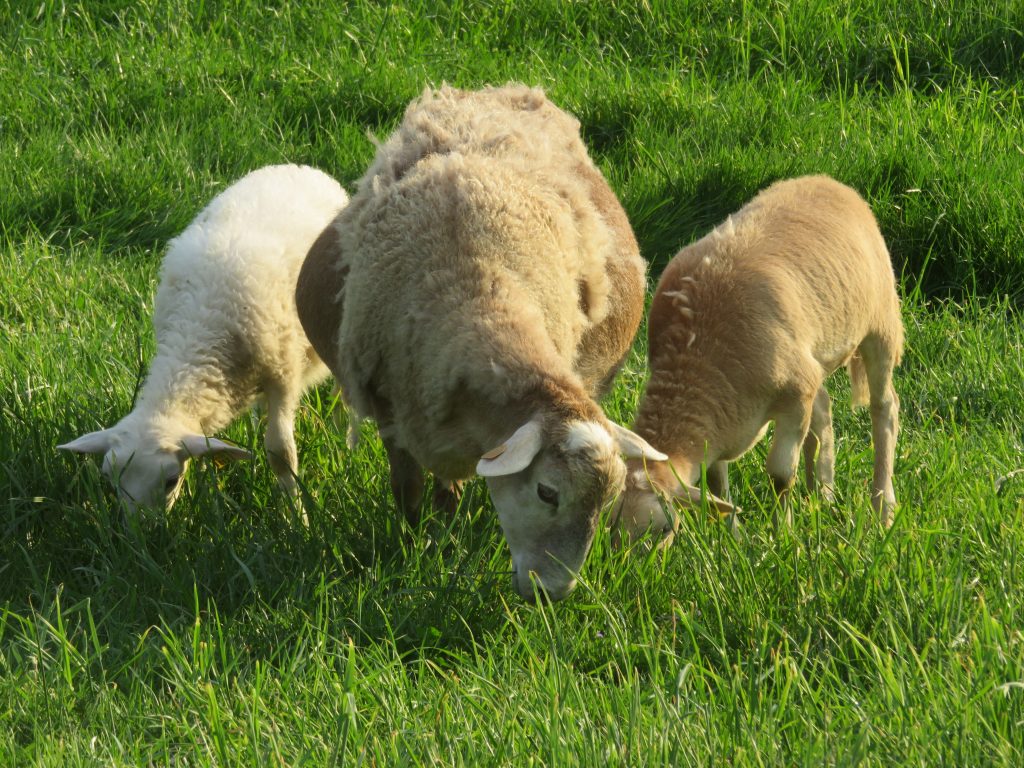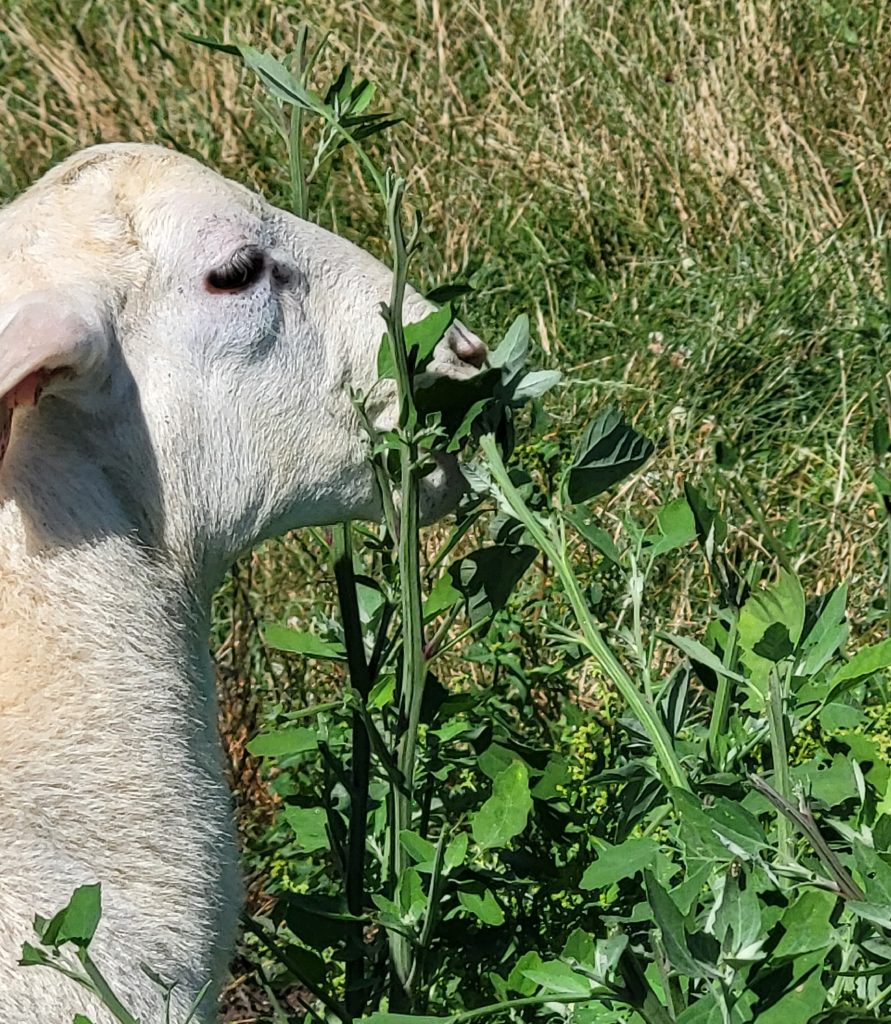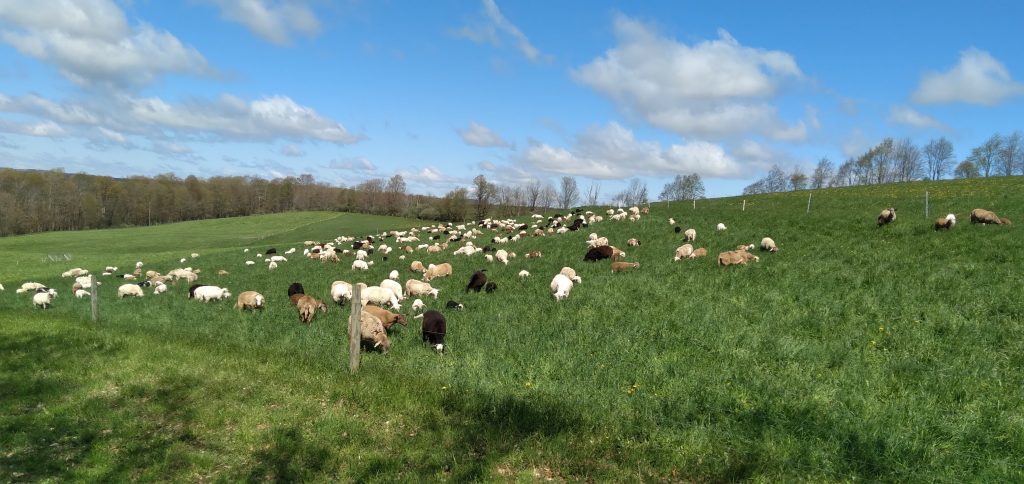While this article focuses on solar grazing, the principles discussed are relevant to all low-input, grass-based production systems. This article was originally published in the August 2025 issue of the Sheep Industry News and is reposted with permission.

The rise of agrivoltaics—where solar energy production coexists with agricultural practices—has created new opportunities for sheep producers across the United States. As solar developers seek sustainable vegetation management solutions, sheep have emerged as an ideal partner, offering cost-effective and environmentally favorable grazing services. However, success in this dual-purpose system depends on more than just turning sheep loose under panels.
A balanced approach to animal selection, emphasizing longevity, adaptability, and health, is essential for flock sustainability, grazing enterprise profitability, and long-term partnerships with solar developers and managers.
Why Sheep?
On solar farms, vegetation under and between solar panels must be controlled to maintain panel operational efficiency, reduce fire risk, and allow personnel to easily work on equipment within the array. Traditional approaches such as mowing and herbicide use are costly, can be logistically difficult, and have negative environmental impacts. Grazing with sheep reduces these costs while adding value through lamb production, positive ecosystem services, and public perception.
Solar development is certainly a polarizing topic amongst the agricultural community and this is something that is recognized by the developers, especially those constructing arrays on valuable farm or pastureland. Maintaining agricultural production at solar sites can maintain a greater level of public support of solar development and fortunately for our industry, sheep are the most suitable species in this scenario.
While perception is highly important to the solar companies, from the perspective of the grazier, it’s important that providing this service is economically sustainable. However, in the scenario of being “paid to graze”, profit may be generated a little differently than we are used to. For an example, a 1000-acre utility-scale solar site in a moderate rainfall region might require four mowing passes per year, at ~$75 per acre per pass, totaling $300,000 in annual mowing costs. By integrating sheep grazing stocked at one ewe per acre, operators may reduce mowing to twice annually, saving $150,000 per year. If a ewe is responsible for one acre, her grazing service alone could save $150 per year.
Consider a ewe purchased as a yearling for $300 and maintained at $30 per year from age two to seven. Over a seven-year lifespan, her total cost is roughly $480. During that time, she could save $1,050 in mowing expenses, not counting revenue from lambs. Even accounting for potential increases in cost, the longer-lived ewe delivers a favorable return. However, a different purchased ewe that only remains in the flock to age four might cost $390 but only save $450—highlighting the economic importance of ewe longevity in solar systems.
While the second ewe still generated profit over her lifetime in our model, we all know that unexpected costs are a reality and her $60 mowing savings could easily get negated. Remember, these are just estimates for the sake of example and you should calculate your own numbers for specific solar sites and production systems.
Longevity vs. Prolificacy: A Production Trade-Off
While prolificacy (lambs per ewe per year) is traditionally a key driver of profitability in sheep operations, its role in solar grazing systems is more complex. Ewes producing larger litters annually may have higher short-term returns but could also face increased physiological stress, potentially reducing their lifespan in the flock.

On the other hand, ewes that consistently produce singles but remain healthy and productive for more years may provide greater total value, especially when grazing services are factored in.
Imagine the same two ewes:
• Ewe A raises seven lambs over seven years.
• Ewe B raises eight lambs over four years (twins each year).
While Ewe B produces one additional lamb ($150), Ewe A provides three extra years of grazing service ($450 in mowing savings). The combined value of longevity and moderate reproduction may outweigh short bursts of productivity.
This scenario is not meant to suggest that prolific ewes should be culled, but rather to highlight the need for balanced selection. The most profitable ewe in a solar grazing system likely falls in the middle of the spectrum—long-lived, moderately prolific, easy fleshing, and resilient to environmental stressors.
Selection Challenges and Genetic Tools
Identifying and selecting ewes with the right combination of traits—longevity, structural and udder soundness, disease resistance, and temperament—requires more than intuition. Comprehensive data collection and objective selection tools are essential but often limited in commercial grazing systems.
The National Sheep Improvement Program (NSIP) offers valuable tools, including Estimated Breeding Values (EBVs) for growth, reproductive, and parasite resistance traits. Of particular importance for solar operations is the Fecal Egg Count (FEC) EBV, which quantifies genetic resistance to internal parasites like Haemonchus contortus.
This trait is critical because solar grazing flocks are often large, mobile, and extensively managed. Variable forage management and inconsistent handling schedules may increase parasite pressure. Ewes must be able to maintain health under these conditions without frequent intervention.
Selection for low FEC EBVs is a proven strategy to improve resistance and reduce dependence on anthelmintics, especially in humid regions where parasite loads are highest. Survival despite disease challenge is not only important to longevity, but ensures positive public perception in a service-based business model.
Producers are encouraged to work with NSIP-participating seedstock suppliers who can provide animals with proven parasite resistance and other performance traits. More information on this topic is available through the American Consortium for Small Ruminant Parasite Control (www.wormx.info).
These EBVs are scientifically proven, accurate selection tools. However, they don’t exist for all traits important to solar graziers. Some traits are more difficult to quantify, and respective genetic metrics have yet to be established in the sheep industry. Therefore, astute observation and recording keeping is necessary for improvement.
Temperament: An Undervalued but Essential Trait
In traditional systems, a calm, docile ewe is often appreciated. In solar grazing, she is essential. The operational realities of solar sites—including frequent trailering, constrained alleyways, breakable infrastructure, and dynamic group management—demand animals that are easy to handle and exhibit strong flocking instinct.
While temperament is largely evaluated subjectively, it remains one of the most practical selection criteria in a solar grazing context. Wild or non-cooperative ewes increase labor costs and elevate risk of injury to people, animals, and equipment. Producers should consistently cull or avoid retaining animals that are difficult to manage. Likewise, positive behavior—such as consistently leading the flock or loading easily—should be rewarded in selection decisions.
Additional Traits to Consider
Beyond the traits of longevity, parasite resistance, and temperament, solar producers may benefit from selecting for the following:

• Moderate Frame Size and Fleshing Ability: Smaller-framed ewes require less input and supplemental feed, maintain condition easier on lower-quality forages, and increase likelihood of breeding offering improved longevity potential.
• Aseasonal Breeding: Ewes capable of lambing outside traditional seasons allow for flexible stocking strategies.
• Nonselective Grazing: Sheep that consume a broad range of plant species are more effective at vegetation control.
• Wool Shedding: Hair sheep or shedding composites reduce labor and costs associated with shearing. More importantly, long wool becomes an animal wellbeing concern as it can become entangled in the driveline and gear system of certain solar arrays.
Not all of these traits are currently associated with formal EBVs, but they can be evaluated through visual appraisal, performance recording, and collaboration with seedstock breeders who emphasize functional traits for extensive environments.
A Call to the Seedstock Sector
Seedstock producers supplying genetics to the solar grazing industry hold a pivotal role in shaping its future. This sector’s long-term success depends on ewes that are not only productive but also well-suited to the unique environmental, health, and behavioral demands of solar arrays.
Breeders who invest in genetic evaluation, collect relevant data, and prioritize traits like parasite resistance, structure, moderation and fleshing ability, along with temperament will be positioned to serve a rapidly growing and economically meaningful market. More importantly, they will help ensure that solar grazing remains a sustainable and profitable component of the broader United States sheep industry.
As agrivoltaics continues to expand, the relationship between renewable energy and sheep production is poised to deepen. Producers who approach this opportunity with scientific insight, economic awareness, and genetic foresight will lead the way in transforming sheep from a commodity into an essential service provider.
By: Jake Thorne and Andrew Weaver

![]()

